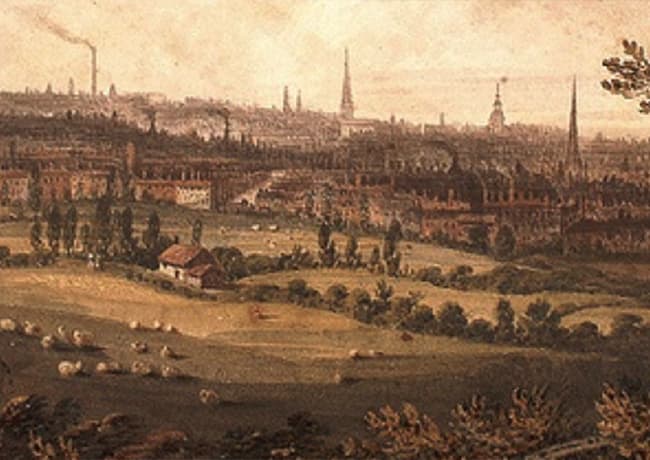
Birmingham can be found near the centre of England and today is the second most populated city in the UK after London. 19th century Birmingham, however, was a small manor with the centre based around the area of St Martin’s and St Philip’s churches. The principal streets were High Street, New Street, Bull Street, Snow Hill, Digbeth, and Dale End. The centre was surrounded by suburbs and countryside where the air was considered healthy and the scenery pleasant.
The Great Expansion
The growth of Birmingham was based on metalworking, with the manufacture of brass articles rapidly rising to importance. Trades were carried out in small workshops rather than large factories. Many entrepreneurs started their businesses producing goods such as buttons, cutlery, nails and screws, guns, tools, jewelry, toys, locks, and ornaments. In addition, there was a large commercial class, consisting of merchants, accountants, agents, stockbrokers, and a great body of clerks.
The Chamber of Commerce was established in 1813. It had significant influence, not only in Birmingham but throughout the United Kingdom. There was a branch of the Bank of England, whose notes were in circulation, as well as many local banks.
Between the censuses of 1851 and 1861, the population of Birmingham increased by over 63,000 from approximately 233,000 to 296,000. The number of inhabited houses within the borough was thought to have increased at a rate of 4,000 per year. By 1868 the parish of Birmingham had a perimeter of about 8 miles while the borough was approximately 21 miles. There were 59,090 inhabited houses. In addition, significant numbers of houses were built beyond the borough boundaries. These houses began to connect Birmingham with the agricultural and mining towns beyond.
Birmingham wasn’t granted City status until 1889.
As the Population Grows, Living Conditions Decline
In the early part of the 19th century, Birmingham was a clean and agreeable place with an abundance of water and good drainage. From 1825, piped water was supplied to those who could afford it from a large reservoir at Aston. There were also numerous pumps and wells, both private and public, and water-carts that sold water to the poor.
It was only in the latter part of the century, as overcrowding became rife, that the sanitary conditions deteriorated. As the wealthy moved to places such as Edgbaston, Balsall Heath and Handsworth, those left in the town centre found themselves living in unacceptable conditions.
Towards the end of the century, it was necessary to clear the slum areas, although work wasn’t completed until the mid 20th century.
Enough Churches for Everyone…
The oldest building in 19th century Birmingham was the original parish church of St. Martin’s, situated in the Bull Ring. It is thought to date back to the 13th century although most of it was re-built in 1873. The church houses monuments to several members of the de Bermingham family reported to be the church’s founders. The de Bermingham’s were lords of the manor and Peter de Bermingham set up the first market in Birmingham in the twelfth century.
The church of St. Philip’s was built in 1715 on what, at the time, was the edge of town. It was designed by the architect Thomas Archer in an ornate baroque style although the chancel was extended in 1880. It is notable for its tower topped by a dome and cupola. St Philip’s was designated a cathedral in 1905.
As the population grew and additional capacity was required, it was necessary to build an additional church in the town centre. Christ Church was built, adjacent to the Town Hall, in 1805 by public subscription. It provided free seating on the lower level to those who in need, lead to it being known as the Free Church. It was demolished in 1897 when many of the towns’ residents moved to the suburbs and attendance at church decreased.
…Even the Dissenters
Any Christian who was not part of the Church of England was considered a dissenter. There were plenty in and around Birmingham in the 19th century, and it is of note that towards the end of the 19th century Birmingham saw more worshipers at Protestant nonconformist churches than at Church of England churches.1
There were a variety of churches to meet their needs and included some large and handsome buildings. As well as catering for the Catholic and Jewish communities they also belonged to Wesleyans, Independents, Baptists, Presbyterians, Quakers and Unitarians.
The Roman Catholic church of St Chad’s was completed in 1841. Based on designs by Pugin, it was built in the shape of a cross from brick with Bath stone dressings. It included a fine rood screen, richly-carved stalls from Cologne, and a splendid pulpit of carved oak from Belgium. The church became a Cathedral in 1850 and is notable for being the first Catholic cathedral to be built in the UK following the Reformation.
The Jewish synagogue in Blucher Street was erected in 1858 at the cost of £10,000.
Connecting Birmingham to the Outside World
The growth of the town was helped by the arrival of the railways in 1837. The first line to open was the Grand Junction Railway linking Birmingham with Liverpool and Manchester. The following year the line to London was opened. It has been reported that in 1838, a journey to the capital would take 5 hours and 38 minutes, and although this is significantly longer than the 1 hour 25 minute (approx) journey you may expect today, it was considerably quicker than the horse-drawn mail coach, which would have taken around 12 hours.
This information was gathered as part of the research for the Ambition & Destiny series. Click here to find out more.
Also see:
Birmingham Chamberlain Square
Birmingham Town Hall
Summer Lane Area









